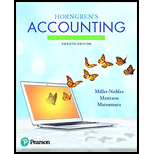
a)
Bonds:
They are long term negotiable instruments of debt issued by corporate entities to secure funds from the public. These funds are used to either fund long term capital expenditure or similar long term investment opportunities.
They represent steady income for the investor in the form of periodic interest payments by the entity issuing the bond. Bonds are issued at par, at premium or at a discount.
If the bonds will be issued at face value, premium or at a discount.
b)
Bonds:
They are long term negotiable instruments of debt issued by corporate entities to secure funds from the public. These funds are used to either fund long term capital expenditure or similar long term investment opportunities.
They represent steady income for the investor in the form of periodic interest payments by the entity issuing the bond. Bonds are issued at par, at premium or at a discount.
If the bonds will be issued at face value, premium or at a discount.
c)
Bonds:
They are long term negotiable instruments of debt issued by corporate entities to secure funds from the public. These funds are used to either fund long term capital expenditure or similar long term investment opportunities.
They represent steady income for the investor in the form of periodic interest payments by the entity issuing the bond. Bonds are issued at par, at premium or at a discount.
If the bonds will be issued at face value, premium or at a discount.
d)
Bonds:
They are long term negotiable instruments of debt issued by corporate entities to secure funds from the public. These funds are used to either fund long term capital expenditure or similar long term investment opportunities.
They represent steady income for the investor in the form of periodic interest payments by the entity issuing the bond. Bonds are issued at par, at premium or at a discount.
If the bonds will be issued at face value, premium or at a discount.
Want to see the full answer?
Check out a sample textbook solution
Chapter 14 Solutions
Horngren's Accounting (12th Edition)
- Accurate answerarrow_forwardQuestion 1 of 12 View Policies Current Attempt in Progress Splish Brothers Express reports the following costs and expenses in June 2022 for its delivery service. Indirect materials used $7,460 Drivers' salaries $18,560 Depreciation on delivery equipment 12,920 Advertising 5,480 Dispatcher's salary 5,800 Delivery equipment repairs 348 Property taxes on office building 1,060 Office supplies 754 CEO's salary 13,920 Office utilities 1,160 Gas and oil for delivery trucks 2,480 Repairs on office equipment 222 Determine the total amount of (a) delivery service (product) costs and (b) period costs. Delivery service (product) costs Period costs - / 12.5 IIIarrow_forwardContribution margin????arrow_forward
- Kevin Richards and Kyle Smith started Book Haven as a corporation, each contributing $65,000 in cash to start the business and receiving 6,000 shares of stock. At the end of the first year of operations on December 31, 2024, the following financial details were recorded: cash on hand and in the bank was $58,400, amounts due from customers for book sales totaled $38,500, and equipment was valued at $62,000. The company owed $12,500 to publishers for books purchased, and there was a one-year note payable to the bank for $7,400. No dividends were declared or paid during the year. Using the retained earnings equation with an opening balance of $0, calculate the net income for the year ending December 31, 2024. HELParrow_forwardFinancial Accounting Question please answerarrow_forwardDetermine the net income for 2024arrow_forward
- Can you explain this general accounting question using accurate calculation methods?arrow_forwardWhat amount should Kollywood record on the books for this machine?arrow_forwardKevin Richards and Kyle Smith started Book Haven as a corporation, each contributing $65,000 in cash to start the business and receiving 6,000 shares of stock. At the end of the first year of operations on December 31, 2024, the following financial details were recorded: cash on hand and in the bank was $58,400, amounts due from customers for book sales totaled $38,500, and equipment was valued at $62,000. The company owed $12,500 to publishers for books purchased, and there was a one-year note payable to the bank for $7,400. No dividends were declared or paid during the year. Using the retained earnings equation with an opening balance of $0, calculate the net income for the year ending December 31, 2024.arrow_forward

 AccountingAccountingISBN:9781337272094Author:WARREN, Carl S., Reeve, James M., Duchac, Jonathan E.Publisher:Cengage Learning,
AccountingAccountingISBN:9781337272094Author:WARREN, Carl S., Reeve, James M., Duchac, Jonathan E.Publisher:Cengage Learning, Accounting Information SystemsAccountingISBN:9781337619202Author:Hall, James A.Publisher:Cengage Learning,
Accounting Information SystemsAccountingISBN:9781337619202Author:Hall, James A.Publisher:Cengage Learning, Horngren's Cost Accounting: A Managerial Emphasis...AccountingISBN:9780134475585Author:Srikant M. Datar, Madhav V. RajanPublisher:PEARSON
Horngren's Cost Accounting: A Managerial Emphasis...AccountingISBN:9780134475585Author:Srikant M. Datar, Madhav V. RajanPublisher:PEARSON Intermediate AccountingAccountingISBN:9781259722660Author:J. David Spiceland, Mark W. Nelson, Wayne M ThomasPublisher:McGraw-Hill Education
Intermediate AccountingAccountingISBN:9781259722660Author:J. David Spiceland, Mark W. Nelson, Wayne M ThomasPublisher:McGraw-Hill Education Financial and Managerial AccountingAccountingISBN:9781259726705Author:John J Wild, Ken W. Shaw, Barbara Chiappetta Fundamental Accounting PrinciplesPublisher:McGraw-Hill Education
Financial and Managerial AccountingAccountingISBN:9781259726705Author:John J Wild, Ken W. Shaw, Barbara Chiappetta Fundamental Accounting PrinciplesPublisher:McGraw-Hill Education





